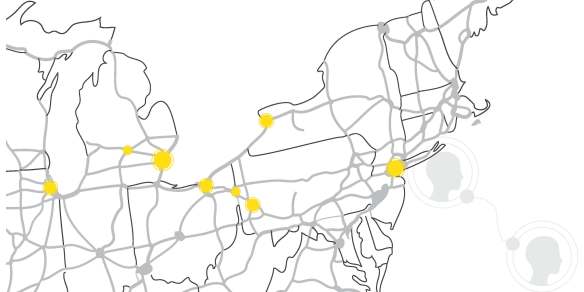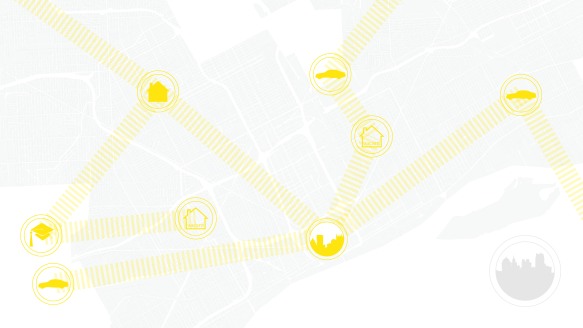
What if Detroit were to become the next Silicon Valley? What if Detroit were to use its history in the automobile industry to be at the forefront of technological advancements? According to Edward Glaesner, the most important aspect for the future of manufacturing cities is the education of its people. The future for Detroit is to educate its people to provide the future to the world. Although so many things are manufactured oversees, so much is dreamed up in countries like the United States. Silicon Valley is vital to the success of the manufacturing processes oversees. San Jose provides the product that the world depends on it. Without the creativity, without the knowhow, without the perseverance, there may not be an Apple, or Intel, or Microsoft. It all starts here. What if the automobile industry started in Detroit?
The U.S. cannot compete in the assembly process of everyday manufacturing anymore. It is just too cheap in Asia. Why fight it? Move to something that no one else can provide. Train the people to do the job that makes all the other jobs. The chip fabrication (Fab) process is like an electronic assembly plant. This manufacturing process is used to create the integrated circuits that are present in everyday electrical and electronic devices. It is a multiple-step sequence of photolithographic and chemical processing steps during which electronic circuits are gradually created on a wafer made or pure semiconducting material. The facilities that house this process are called “fabs.” The fab provides a wide range of jobs, from high level engineers, to business people and testing and laboratory personnel.
The best example of a city like San Jose is Austin. Austin, known as Silicon Hills, provides a similar service to the world as San Jose, chip design and manufacturing. It provides much of the brain power and invention that technological companies need in order to produce product. If new product is not designed in San Jose, more than likely it was in Austin. A prime example of the work Austin has put into its vision came true in 2006, when Samsung opened a Fab in Austin. This is significant because this is only the second one they had opened. This gave jobs to Americans with a company founded in Korea. It is a wide range of jobs, from high level engineers, to business people and testing and laboratory personnel.
Detroit could become a fab for the automobile industries. Cars are becoming more electronic every day. Muscle cars are being replaced with hybrid. Cars that look like muscle cars, such as the Tesla, have a speaker system installed to make them sound like a muscle car instead of a Prius. Can you imagine seeing a Camero or Mustang driving down the road, but you couldn’t hear it? If the future is flying cars, doesn’t that mean more electronic parts? Sounds like the future is revving up in Detroit.
In order for Detroit to progress into the twenty-first century and garner some of the luster it once had, it will need to transcend its current analog environment and move into the digital age. This will require a complete transformation of the city and the fabric that has made it such a manufacturing genius. The infusion of digital technology into all aspects of the city culture, education, economy and lifestyle is the only way to keep up with the ever-changing world and reverse the effects of the recent economic crash in the United States.
This project will concentrate on the digital transcendence of the City of Detroit, particularly within the manufacturing community. The infusion of technology can occur at many different scales and this project will involve stitching the macro(world) to the micro(individual). Within each scale, there will be investigations and research into how Detroit can be digitally infused to once again compete in the global market. The transformations will center around technology and digital strategies that can help transition the analog manufacturing techniques used in within the city.

In order for Detroit to progress into the twenty-first century and garner some of the luster it once had, it will need to transcend its current analog environment and move into the digital age. This will require a complete transformation of the city and the fabric that has made it such a manufacturing genius. The infusion of digital technology into all aspects of the city culture, education, economy and lifestyle is the only way to keep up with the ever-changing world and reverse the effects of the recent economic crash in the United States.
This project will concentrate on the digital transcendence of the City of Detroit, particularly within the manufacturing community. The infusion of technology can occur at many different scales and this project will involve stitching the macro(world) to the micro(individual). Within each scale, there will be investigations and research into how Detroit can be digitally infused to once again compete in the global market. The transformations will center around technology and digital strategies that can help transition the analog manufacturing techniques used in within the city.
Stitching is the art of joining, mending, or fastening with or as if with stitches. In the case of this project, the digital technology is the thread that will stitch each one of these elements together. As in sewing, each stitch is critical to the overall success of the material being created. In order for Detroit to transcend into the digital age of manufacturing, each of these elements will have to work together seamlessly.

There are well known manufacturing cities all over the world. Each of these cities has seen its ups and downs over the last century. It is their ability to adapt to the changing world and market that allows them to maintain an edge in the global manufacturing sector.
China has been the biggest mover over the last couple of decades. This is well documented in the film Manufactured Landscapes, which illustrates through photography the effects manufacturing is having on the environment and people of China. Although the Chinese are at the front of the line at the moment, they will need to adapt over time to stay in this position.
Detroit needs to adapt its role in the global market. A digital infusion and diversification of manufacturing processes that interconnects to the world market will reposition the city in a different but familiar role in the future.

The “Rust Belt” bolsters the once king of manufacturing economies in the world. This region alone accounted for a large portion of the world’s manufacturing. Many of the cities in this region have already experienced transformations due to shifts in manufacturing needs. Pittsburgh and Chicago saw this happen in the 1950’s with steel manufacturing. At this moment, other cities like Cleveland and Buffalo are experiencing similar misfortunes as Detroit.
These cities are stitched together by more than just highways and infrastructure. They share many of the same waterways and rail lines as well as a similar demographic full of blue collar workers. Most importantly, they all have experienced moments of decline and can provide examples of successful strategies.
All these cities need each other, and it is when they are working together that they can be at their highest potential.

The City of Detroit has long relied on the manufacturing located throughout the city. There are many different types of manufacturing that occur in and around the city, but its strongest sector has been automobiles. Although many other companies and countries have come into the business over the years, the rich history lies within the walls of the automobile plants in Detroit.
Due to the economic collapse in the United States, many of the automobile manufacturers in the city have struggled or ceased to exist. This fracturing has had a ripple effect on many of the other manufacturing processes located throughout the city.
The goal is to stitch the fractured city back together, and in order to do this each industry must be connected to make a stronger product. They must be consolidated and woven into the fabric of the city, shrinking the overall footprint and bringing everyone closer together.

At the heart of the manufacturing process is the people that make everything happen. Detroit has long relied on the blue collar workers that fill its buildings with movement and activity every day.
Edward Glaeser says in his book Triumph of the City, “To thrive, cities must attract smart people and enable them to work collaboratively.” He argues that some old industrial cities like Detroit are dying because they fail to educate their population to reinvent the role of manufacturing in the city. Boston has been able to do this several times, and thus has rebounded nicely from similar plights as the one Detroit is experiencing at the moment.
















